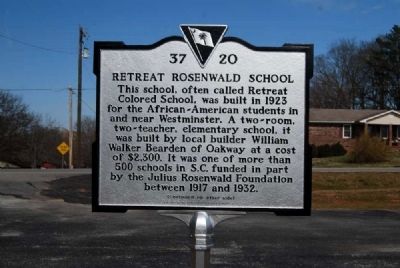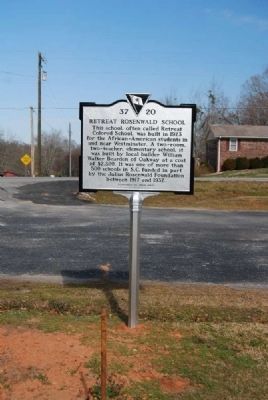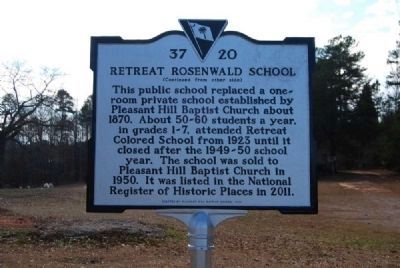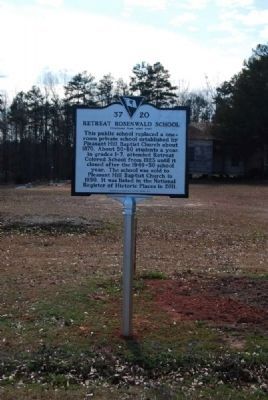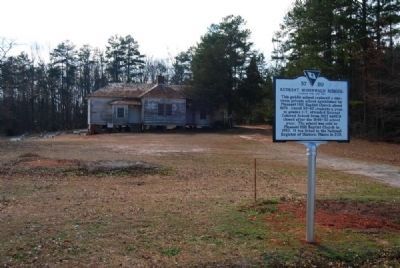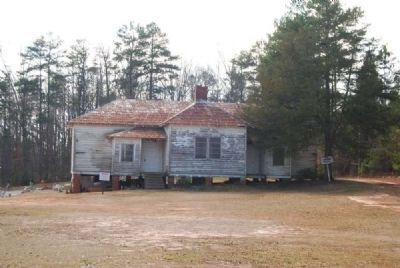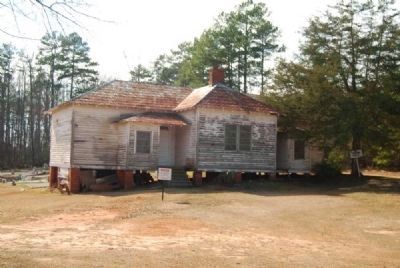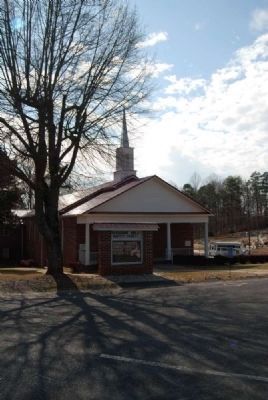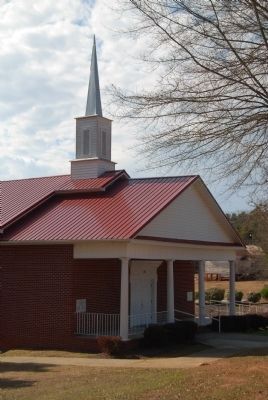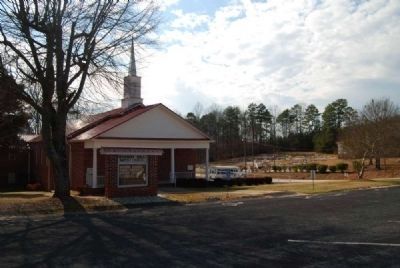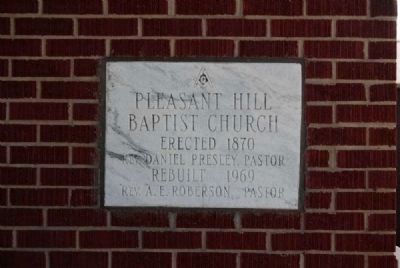Westminster in Oconee County, South Carolina — The American South (South Atlantic)
Retreat Rosenwald School
[Front]:
This school, often called Retreat Colored School, was built in 1923 for the African-American students in and near Westminster. A two-room, two-teacher, elementary school, it was built by local builder William Walker Bearden of Oakway at a cost of $2,300. It was one of more than 500 schools in S.C. funded in part by the Julius Rosenwald Foundation between 1917 and 1932.
[Reverse];
This public school replaced a one-room private school established by Pleasant Hill Baptist Church about 1870. About 50-60 students a year, in grades 1-7, attended Retreat Colored School from 1923 until it closed after the 1949-50 school year. The school was sold to Pleasant Hill Baptist Church in 1950. It was listed in the National Register of Historic Places in 2011.
Erected 2012 by Pleasant Hill Baptist Church. (Marker Number 37-20.)
Topics and series. This historical marker is listed in these topic lists: African Americans • Education. In addition, it is included in the Rosenwald Schools series list. A significant historical year for this entry is 1923.
Location. 34° 38.483′ N, 83° 3.852′ W. Marker is in Westminster, South Carolina, in Oconee County. Marker is on 150 Pleasant Hill Circle, in the median. Touch for map. Marker is in this post office area: Westminster SC 29693, United States of America. Touch for directions.
Other nearby markers. At least 10 other markers are within 7 miles of this marker, measured as the crow flies. Westminster Depot (approx. 2˝ miles away); Westminster World War I Monument (approx. 2.8 miles away); Westminster First Baptist Church World War I Monument (approx. 2.8 miles away); Westminster Confederate Monument (approx. 2.9 miles away); Center Methodist Church (approx. 4.4 miles away); First Soil Conservation District Plan (approx. 6 miles away); Seneca Institute / Seneca Junior College (approx. 6˝ miles away); Capt. Samuel Earle (approx. 6.6 miles away); Seneca Firsts (approx. 6.9 miles away); Seneca (approx. 6.9 miles away). Touch for a list and map of all markers in Westminster.
Also see . . .
1. Retreat Rosenwald School. The Retreat Rosenwald School, built in 1924, is significant for its association with African American public education during the first half of the twentieth century and as an extant example of an architectural design typically associated with the schools funded in part by Julius Rosenwald. (Submitted on March 5, 2012, by Brian Scott of Anderson, South Carolina.)
2. Rosenwald School. A Rosenwald School was the name informally applied to over five thousand schools, shops, and teachers' homes in the United States which were built primarily for the education of African-Americans in the early 20th century. (Submitted on March 5, 2012, by Brian Scott of Anderson, South Carolina.)
3. Julius Rosenwald. Julius Rosenwald (August 12, 1862 – January 6, 1932) was a U.S. clothier, manufacturer, business executive, and philanthropist. (Submitted on March 5, 2012, by Brian Scott of Anderson, South Carolina.)
4. Rosenwald Fund. The Rosenwald Fund (also known as the Rosenwald Foundation, the Julius Rosenwald Fund, and the Julius Rosenwald Foundation) was established in 1917 by Julius Rosenwald and his family for "the well-being of mankind." (Submitted on March 5, 2012, by Brian Scott of Anderson, South Carolina.)
Additional commentary.
1. Retreat Rosenwald School - National Register Nomination Form (2011)
Summary Paragraph
The Retreat Rosenwald School is a two-room building located at 150 Pleasant Hill Circle approximately one
and one-half miles east of Westminster, South Carolina. The school is situated on 2.55 acres of land owned by Pleasant Hill Baptist Church. The building was completed in 1924 for a total cost of $2,300, including $700 from the Julius Rosenwald Fund. The local builder was William Walker Bearden of Oakway, South Carolina. It was one of ten Rosenwald Schools built in Oconee County; the only other one extant is in Seneca. The building is oriented northwest to southeast and lateral to the road. Its surroundings presently include the Pleasant Hill Baptist Church, Pleasant Hill Cemetery, woods, and farmland. The school was built on an open field; however, the Pleasant Hill Cemetery now (2011) includes some of the original open land to the rear of the building. The school served the African American community in the Westminster area from 1924 until 1950, when the Retreat Rosenwald School was closed because student enrollment had decreased significantly.
Narrative Description
Exterior
The Retreat Rosenwald School is a one-story, wood frame building with a brick pier foundation, white weatherboard siding, and a metal roof. It is T-shaped with entrances on either side of the forward wing. Each has a small-engaged porch which opens into a classroom. The chimney is centrally located. The original panel configuration consisted of two sets of six windows on the southwest side of the building, but these have been removed or covered. Several of these windows are stored under the building; other windows are boarded up to prevent vandalism. The windows located on the northeastern side are located in the kitchen at the two cloakrooms.
The school is situated with a northwest to southeast orientation. This deviates somewhat from the specifications laid out by Samuel L. Smith’s Community School Plans for Rosenwald Schools, which calls for a north-south orientation. The school’s orientation is parallel to the road, however, and the southwest orientation of the large windows would increase the amount of sunlight in the winter and decrease it in the summer.
No longer extant are two privies that were located in the rear of the building approximately 500 feet from the school. A well house, no longer extant, sat approximately seventy-five feet in front of the school.
Interior
The floor plan is typical of a two-teacher community school—floor plan number 20-A—recommended in Bulletin No. 3 by the Julius Rosenwald Fund. Each of the building’s interior doorways has transoms to increase the amount of available natural light and air circulation. The moldings throughout the building are plain with no enhancing accents. Much of the original flooring is evident throughout the building. The lower portions of the interior walls are painted brown which gives the appearance of wainscoting approximately four feet above the floor. Above the simulated wainscoting there is horizontal tongue and groove wood sheathing that is painted white. The ceilings also consist white tongue and groove sheathing similar to the walls.
The building has three main rooms consisting of two classrooms and an industrial room in the forward projecting wing. The two classrooms were separated by a detachable dividing wall. The removal of the dividing wall created a large space for special events. The northwestern classroom served younger students while the southeastern room served older students. Each classroom had a connected cloakroom for the storage of students’ coats, lunches, and other school materials. A kitchen was located on the northern side of the building. There is a wood stove that was used for heating and cooking.
Integrity
The Retreat Rosenwald School, an intact example of Two Teacher School Plan 20-A, meets the Registration Requirements as established in the Multiple Property Submission “The Rosenwald School Building Program in South Carolina, 1917-1932,” approved by the National Park Service in 2008.
Though the school has undergone exterior alterations, the building retains a satisfactory degree of historic integrity sufficient to convey its historic architectural character. The windows on the southwestern elevation originally consisted of two gangs of six windows. Both gangs of windows have been replaced or covered. The overall form of the building has not been altered so as to no longer convey its historic appearance as an early twentieth century schoolhouse. Likewise, its rural setting and proximity to a church is typical for a Rosenwald School. The interior retains a high degree of integrity. The building contains the original floor, doors, and storage spaces. Several pieces of original furniture such as desks, stoves, cabinets, and drawers remain in the school. These elements help to convey the historic appearance of a Rosenwald school.
Statement of Significance Summary Paragraph
The Retreat Rosenwald School in the vicinity of Westminster, South Carolina, was built in 1924 to serve the local black community. It is eligible for listing in the National Register of Historic Places under Criterion A for its association with African American public education and ethnic heritage during the first half of the twentieth century. It is also eligible under Criterion C as an extant example of an architectural design typically associated with the schools funded in part by Julius Rosenwald. The Julius Rosenwald Fund sought to improve schools for African Americans in the rural South. The multiple property submission for the Rosenwald School Building Program, 1917-1932, states that Rosenwald schools are eligible under Criterion A (Education and Ethnic Heritage – African American) and Criterion C (Architecture). In addition to their architectural significance, extant Rosenwald Schools reflect the struggle of black communities to give their children better educational opportunities. Rosenwald schools also reflect the strong bonds of community: the public space became an important social center for rural blacks. The Retreat Rosenwald School, operating from 1924 to 1950, conveys all of these aspects of its history. It is significant at the local level for architecture, its association with the educational reform, and its historical importance in the local black community.[1]
Narrative Statement of Significance
Education
Rosenwald schools were one of the most significant movements in African American education in the first half of the twentieth century.[2] Education for African Americans during this time was anything but equal, and the educational opportunities for African Americans were inadequate. A great disparity existed between funding for black and white schools. The number of black and white students was nearly equal in 1922, but the state spent $1,970,944.20 on white schools and only $187,033.63 on black schools. Likewise, South Carolina spent $188,155.02 on furniture and repairs for white schools but only $22,983.00 for black schools. White students received nearly ninety percent of the state funds.[3] That South Carolina had the second lowest literacy rate in the country suggests the severity of education problems in the state.[4] The state supervisor of elementary rural schools reported in 1910:
Frequently, the county superintendent does not know where they [the Negro schools] are located and sometimes the district board cannot tell where the Negro school is taught. It is customary for the board to allot a certain amount of money to the Negroes and allow them to use it as they please. A teacher is employed and no further questions are asked, except concerning enrollment at the end of the session.[5]
The county distribution of funds at the local level in South Carolina, as well as any instructional oversight, was highly uneven between blacks and whites.
The Julius Rosenwald Fund had a profoundly positive impact upon education in South Carolina, especially during the 1920s at the height of the program. The addition or replacement of educational facilities brought about a marked change in the amount of funding per student for black children in South Carolina. In 1917, the year the Rosenwald Fund was established, the yearly average instructional cost per black student was $2.86. Ten years later, that figure had increased to $11.06. Likewise, the number of available black teachers increased from 3,100 in 1917 to 4,300 in 1927 to meet the needs of the new schools.[6] As one of nearly 5,000 Rosenwald schools constructed in the South, and one of almost 500 constructed in South Carolina between 1917 and 1932, the Retreat Rosenwald School reflects an important movement in African American education in the segregated South in general and in South Carolina in particular.
Architecture
The architectural style of the Retreat Rosenwald School reflects an important movement in schoolhouse design and construction. The Rosenwald schools in South Carolina are divided into two subtypes: Subtype 1 includes buildings constructed between 1917 and 1920; and Subtype 2 comprises school buildings built between 1920 and 1932.
The Retreat Rosenwald School is an example of Subtype 2. These school buildings reflected the designs and specifications of Samuel L. Smith and were built under the supervision of the Rosenwald Southern office in Nashville, Tennessee.[7] Rosenwald schools were designed with two primary functions in mind: facilitating education and providing important public space for rural communities. Smith’s Community School Plans stressed particular designs and guidelines in school building construction. The Retreat Rosenwald School was built according to a typical design found in South Carolina—Samuel Smith’s Plan Number 20-A.[8]
There are approximately thirty-five extant Rosenwald schools in South Carolina; six of them have already been listed in the National Register of Historic Places:[9]
School, Pomaria vicinity, Newberry County: Listed 3 October 2007
At least seven extant Rosenwald schools in the state were built according to Plan Number 20 or its east-west variant, Number 20-A. In addition to the Retreat Rosenwald School, the other six schools featuring Plan Number 20 or Plan Number 20-A are:
Hope Rosenwald School, Pomaria vicinity, Newberry County, Type 20 *
High Hill Rosenwald School, Sumter vicinity, Sumter County, Type 20-A ****
* Listed in the National Register 3 October 2007.
** Considered by the South Carolina SHPO as eligible for listing in the National Register.
*** Considered by the South Carolina SHPO as not eligible for listing the National Register.
**** Not yet evaluated by the South Carolina SHPO for eligibility for listing in the National Register.
The
design of Rosenwald schools exemplify the changes that were taking place in schoolhouse construction. Principally, Smith’s plans were justified in terms of efficiency and utility. As two-teacher buildings, Types 20 and 20-A were expected to have two acres of land “for the schoolhouse, two sanitary privies, a teachers’ home, playgrounds for the boys and girls, a plot for agricultural demonstrations, and proper landscaping.”[10] The location of the building was set so that every class room would receive east or west sunlight. While the Retreat Rosenwald school did not sit on an exact north-south axis, its northwest-southeast orientation allowed for more direct sunlight in the winter and less sunlight in the summer. Even the interior wall paint served functional purposes: increase the amount of light, make the interior more “pleasing and restful to the eyes,” improve sanitary conditions, and increase the durability of the building.[11] Smith’s Community School Plans for Rosenwald Schools provided color schemes which were a condition of Rosenwald funding.[12] The Retreat Rosenwald School was also a multi-use building. A dividing wall separated lower and upper grades, but the wall could be removed to create a larger space for special school and community events. This link between school and community and the development of modern educational buildings
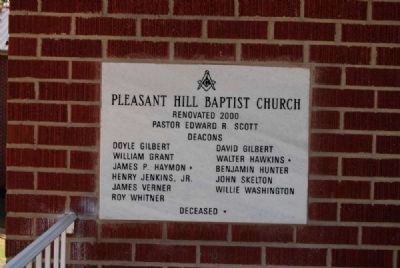
Photographed By Brian Scott, February 28, 2012
12. Pleasant Hill Baptist Church 2000 Cornerstone
Pleasant Hill Baptist Church
Renovated 2000
Pastor Edward R. Scott
Deacons
Doyle Gilbert, David Gilbert
William Grant, Walter Hawkins*
James P. Haymon*, Benjamin Hunter
Henry Jenkins, Jr., John Skelton
James Verner, Willie Washington
Roy Whitner
Deceased *
Ethnic Heritage – African-American
In addition to providing better school facilities for African American children, Rosenwald Schools became active community centers for rural blacks engaged in political activism, church activities, local fundraisers, and celebrations. The buildings were expected to serve the community all year: for this reason plan 20-A called for a movable partition so that the building could serve as an auditorium.[13] These buildings were intended not only to teach children but also to bring rural people together to improve farming techniques and strengthen local communities.
Oral interviews indicate that the Retreat Rosenwald School was a focal point for the local community. Curtis Childers Moon, the daughter of schoolteacher Mrs. Velma Childers, recalls that her mother taught adults at night on the importance of registering to vote and voting in elections. Rural sharecroppers were taught basic math and how to read and write at night because they were working during the day.[14] Verbena Childers Hicks and Samuel Grant recall that every 4th of July local families came together for a picnic. They brought various sweets, hot dogs, fried fish, and homemade ice cream. Students and adults played baseball and horse shoes. Mr. Allen Childers, a blacksmith, donated the horse shoes and the balls were made from a walnut wrapped with strings. The bats were made from tree limbs. In the fall, after harvesting, a festival was held in the community. The Retreat Rosenwald School served as a cultural center for community fairs, fish fries, cake baking, sewing classes, quilting displays and vegetable displays for the largest pumpkin in the area.[15] Thus, the school served as the hub for community activities for decades.
Developmental history/additional historic context information
Bachelor’s Retreat and Pleasant Hill Baptist Church
Near the Retreat Rosenwald School was a community known as Bachelor’s Retreat, established by John Verner, Jr. in 1812. Samuel Verner, the brother of John, had three sons: Ebenezer, Limuel and David and for a long time all three sons were bachelors. Ebenezer and Limuel eventually married but David remained a bachelor; hence the name Bachelors Retreat. The community had a store, a whisky dispensary, a cotton gin, a grain mill and a post office. Thus, the district name “Retreat” refers to this piece of local history.[16]
The origins of Retreat Rosenwald School are closely connected with the Pleasant Hill Baptist Church, a one room building constructed in the 1870s. In the year 1879, ten churches organized the Seneca River Missionary Baptist Association. The ten churches were Snow Hill, Parker, (now known as Shiloh), Mt. Sinai, Cheohee, Flat Rock, Double Springs, Pleasant Hill, Mt. Nebo No.1, Abel and New Light. Several of the above churches had one room school houses for the families in their community.
From the beginning Pleasant Hill Baptist Church held a school on Sundays. The primary focus of the school was reading: reading enabled them to practice religion while exercising and protecting their tenuous freedom after the Civil War. A school was built adjacent to the spot where the church cemetery is now located. The length of the school term was three months, typically following the agriculture cycle, breaking for planting and harvesting.[17] One of the benefits of the Rosenwald Fund was the condition that schools were to have six-month terms.
Building the Retreat Rosenwald School
As early as 1909, the Oconee County Board of Education discussed changing the location of the “Negro School House,” which at that time was located on the property of M.S.H. Snead, a white landowner. The Board agreed to relocate the school to black-owned property.[18]
The construction of the Retreat Rosenwald School in 1924 was an important change in the educational opportunities for students in the Retreat community. It was one of ten new schools in Oconee County constructed by local contractor William Walker Bearden and funded through the State Department of Education and the Julius Rosenwald Fund.[19] The Retreat Rosenwald School was typical in construction of a “two teacher” type school that served grades one through seven. The teachers were Mrs. Margie Doyle Childers, Mrs. Lillie Poole Morton, Mrs. Lurlie Gideon Grant, Mrs. Ellen Ladd Oglesby, Mrs. Snow Byrd Harrison Scott, Mrs. Nannie Jackson, and Mrs. Velma F. Gideon Childers. All teachers except Mrs. Jackson were graduates of Seneca Institute/Seneca Junior College. The school influenced many in the local community through day and night classes. The school was the hub for community activities, bringing families together through school plays, fairs, fish fries, quilting and sewing classes. Many students continued their education at Seneca Institute/Junior College, Westminster Colored High school or the Oconee Training School in Seneca, South Carolina.[20]
The Retreat Rosenwald School had a large enrollment. In 1933, the total enrollment was ninety students, though average enrollment between 1933 and 1946 was sixty-seven students. During the school years of 1933-1934 and 1934-1935, average attendance was only 66 and 68 percent, respectively. Overall, however, average attendance was 78 percent. In 1950, the year the school closed, total enrollment had decreased to only thirty-five students.[21]
Remembering the Retreat Rosenwald School
While much is known about the Rosenwald Fund from written records, most information directly pertaining to the Retreat Rosenwald School comes from people associated with the school during its operation. These interviews provide insight into the day-to-day operation of the school.
Dorothy Patterson Holland recalls walking to and from school daily with her sister Sally, along with the Berry children. Once they arrived at school, they always recited the Pledge of Allegiance. Mrs. Velma Childers was Mrs. Holland’s teacher during the time she attended school.[22]
Retreat Rosenwald School suffered from a lack of instructional materials. One of the former students, Edith Childers Harris recalls that their textbooks were passed down from the white schools.[23]
Hazel Evett Walker, states that students had to be on their best behavior at school all the time. If not the teacher would correct them at school and their parents would correct them, again, at home. Hazel recalls that she loved school and her teachers, Mrs. Velma Childers and Mrs. Margie Childers. They were good teachers; they were strict but they were fair. They always had some type of devotion before beginning their lessons for the day. Hazel says that the devotions made a difference in the way the rest of the day went. Older students helped prepare the meals, peeled potatoes, washed the dishes and whatever else needed to be done. They took the lunch food to the youngest students. The other students went to the kitchen to pick up their food. The pot belly stove kept them warm in the winter. In the summer, the shutters, windows and doors were opened to keep cool. There was a wooden box to put wood in for the heaters and stove. The older boys brought wood in to use for the heaters before they left to go home for the day. These students also drew water from the well for cooking and drinking.[24]
Lila M. Poole recalls the Jeanes’ teacher, Miss Catherine Johnson. Miss Johnson came to the school once a month to check on how the teachers were teaching, the cleanliness of the building, student’s personal hygiene and to speak with the older students on home economics. She also passed out Lifebuoy soap and Ipana toothpaste to the students.[25]
The Retreat Rosenwald School closed in July 1950 because of the decreased enrollment. The students were sent to Westminster Colored School located on Butler Street in the city of Westminster, South Carolina. In December 1950, the trustees, John S. Lay and Ross Pitts sold Retreat Rosenwald School to Allen Childers, Leonard Poole, Frank Hunter and Tupper Childers, deacons of Pleasant Hill Baptist Church.[26] Since the closing of the school in 1950, several families have used the building as temporary housing during emergencies after their homes were destroyed by fire. In the sixties, the building was a place of worship while the new church was being erected in 1968.[27]
Notes
1 Lindsay C. M. Weathers, National Register of Historic Places, Multiple Property Listing, “The Rosenwald School Building Program in South Carolina, 1917-1932,” South Carolina State Historic Preservation Office (SHPO), South Carolina Department of Archives
and History, p. 70, hereafter cited as South Carolina SHPO.
2 Ibid.
3 State Department of Agriculture, Commerce, and Immigration, Handbook of South Carolina, Resources, Institutions, and Industries of the State…(Columbia: The State Company, 1907), pp. 1094-95.
4 Handbook of South Carolina, p. 1086.
5 South Carolina Superintendent of Education, Annual Report, 1910, 120; Katherine H. Richardson, et al, National Register of Historic Places, Historic Context, “African-American Primary and Secondary Public School Buildings in South Carolina, 1895-1954,” South Carolina SHPO.
6 Program, “Rosenwald School Day, Friday, March 30, 1928,” copy in South Carolina SHPO.
7 Weathers, “The Rosenwald School Building Program in South Carolina, 1917-1932,” p. 68.
8 Julius Rosenwald Fund, Community School Plans, Bulletin No. 3 (Julius Rosenwald Fund: Nashville, 1924), p. 6.
9 A seventh historic resource associated with the Rosenwald school program in the state, The Great Branch Teacherage near Orangeburg, in Orangeburg County, was listed in the National Register on 24 October 2007; the Great Branch Rosenwald School once associated with it is no longer extant.
10 Community School Plans, p. 1.
11 Community School Plans, p. 29.
12 Community School Plans, pp. 2, 29.
13 Community School Plans, p. 1.
14 Helen Rosemond-Saunders, Interview with Mrs. Curtis Childers Moon, Oconee County, S.C., December 2010. Hereafter cited as Interview with blank, with place and date as Oconee County, S.C., December 2010, unless noted otherwise.
15 Interview with Mrs. Verbena Childers Hicks and Mr. Samuel Grant.
16 Claude and Irene Neuffer, Names in South Carolina, Volume I – XII, 1954-1965.
17 Pleasant Hill Baptist Church 140th Anniversary Commemorative Booklet (N.P.: Privately Printed, 2009).
18 Oconee County, South Carolina, School Board Minutes, 1909, Records of the Oconee County Department of Education, Walhalla, S.C.
19 Interview with William Walker Bearden’s granddaughter, Mrs. Flora Riley, November 2010.
20 Naomi Childers, Research on the History of Pleasant Hill Baptist Church School, copy in the South Carolina SHPO.
21 “Retreat Rosenwald School, Retreat School District #8, Oconee County, Westminster Vicinity,” Records of the South Carolina Department of Education, South Carolina Department of Archives and History.
22 Interview with Mrs. Dorothy Holland.
23 Interview with Mrs. Edith Childers Harris.
24 Interview with Mrs. Hazel Evett Walker.
25 Interview with Mrs. Lila M. Poole.
26 Deed for Pleasant Hill Baptist Church, Westminster vicinity, Oconee County, South Carolina, on file at the Oconee County Register of Mesne Conveyance, Walhalla, S.C.
27 Remarks by Pleasant Hill Baptist Church Retreat Rosenwald Committee members.
— Submitted March 5, 2012, by Brian Scott of Anderson, South Carolina.
Credits. This page was last revised on September 17, 2020. It was originally submitted on March 4, 2012, by Brian Scott of Anderson, South Carolina. This page has been viewed 1,530 times since then and 45 times this year. Photos: 1, 2, 3, 4. submitted on March 4, 2012, by Brian Scott of Anderson, South Carolina. 5, 6, 7, 8, 9, 10, 11, 12. submitted on March 5, 2012, by Brian Scott of Anderson, South Carolina. • Bill Pfingsten was the editor who published this page.
